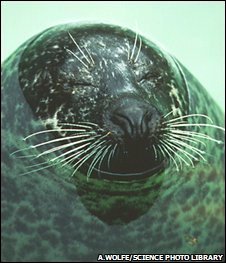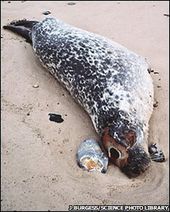Harbour seals, or common seals, are familiar faces along coastlines across 
Drowning, not waving - harbour seal numbers have halved in some areas
But they are now vanishing in the UK at an alarming rate, warn scientists from St Andrews University.
Numbers have halved in the hardest hit area, the Orkney Islands, since 2001 - falling almost 10% each year.
There will soon be "no harbour seals left" in some areas if the mysterious decline continues, said Professor Ian Boyd, of the Sea Mammal Research Unit.
Marine biologists are baffled by the disappearances and have begun investigating possible causes, which include illegal hunting and disease.
"The change in numbers is well outside normal limits and the decline appears to be accelerating," said Professor Boyd.
"We're worried that
over the next 10 years, there will be no harbour seals left in the core area for the animals in Europe."The harbour seal (
Phoca vitulina) is found in cold and temperate waters throughout much of the northern hemisphere. The UK is home to 40% of the European population.
Also known as the common seal, they are a familiar sight around the UK's coasts - much more so than their more elusive cousin, the grey seal.
However, the latest report shows dramatic decreases in the numbers around most of Scotland.
When compared with figures from 2001, counts in 2007 showed drops of 56% in Orkney, 42% in Shetland and 30% in Strathclyde.
Researchers have seen similarly worrying declines along the Scottish east coast, and along the North-East coast of England.
"We really don't know what's behind this," Boyd admits.
"It looks like the problems are likely to be complex and the decline in numbers is probably down to a combination of factors.
"It could be a change in the ecosystem. We know that the grey seal is moving into harbour seal territory and this might be having an effect on the harbour seal.
"But we don't really know the nature of the competition between the two species. We do know that both feed on sand eels, which are also in decline."
Worrying trendThe decline in harbour seals reflects a similar trend in North Sea marine life.
Puffin numbers have fallen 30% over the past five years, according to a recent study

There is no evidence so far that disease is responsible for the decline
on the Isle of May, off Scotland's east coast, by scientists from the UK Centre for Ecology & Hydrology.
And a decline in sand eels has been reported by the Fisheries Research Service, in Aberdeen.
There is no evidence, so far, of any kind of parasite-mediated infection of harbour seals.
Grey seal populations seem to be healthy, but Professor Boyd added that grey seals could be more robust than harbour seals, which seem to be more susceptible to disease.
In 1988, an outbreak of phocine distemper virus (PDV) killed around 18,000 harbour seals in European waters, over half the population in some areas.
Disappearing ActThe population had recovered fully by 2002, when a second outbreak began, in which several thousand seals died. There is no cure or prevention for the disease.
Common seal numbers are monitored annually in the UK, with funding from the Natural Environment Research Council, which published the results of the latest survey.
NERC advises the UK government on the size and status of the British seal population under the Conservation of Seals Act, 1970.
Some environmental groups want the Scottish government to use powers under the proposed marine bill for Scotland to legally protect harbour seals, by abolishing the Act.
At the moment, it is legal to shoot harbour seals that come near fisheries.
Reader Comments
to our Newsletter